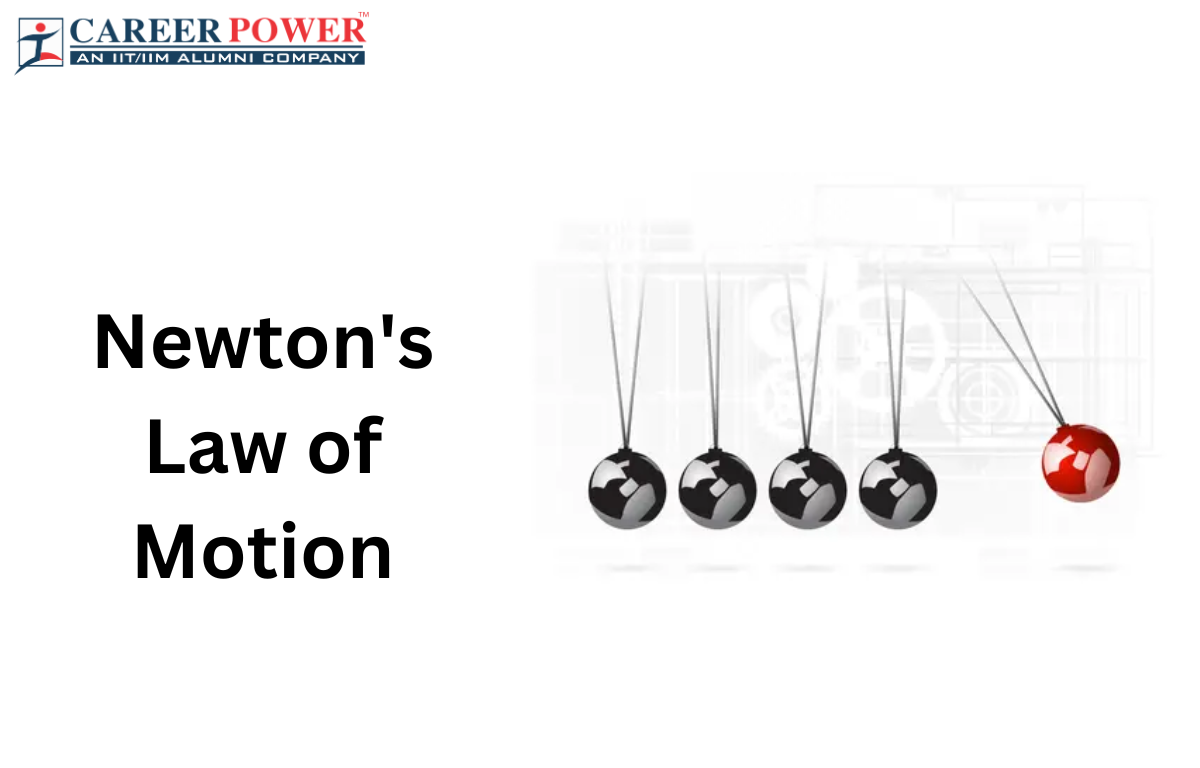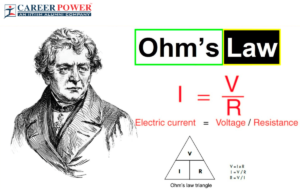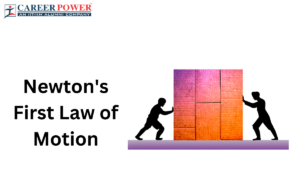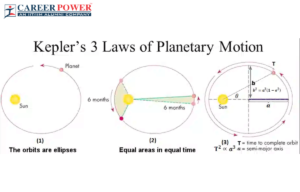There are three statements describing the relationship between the actual force acting on the body and the actual motion of that body named Newton’s Three Laws of Motion. This relationship was discovered by Isaac Newton and published in 1687. These three laws of Newton helped us to understand how objects conduct themselves well when standing still or at rest position and when moving and also when we acted forces upon them. All of Newton’s three laws are fundamental in nature because the first law introduces the ideas of force and inertia, the second law defines force, and the third law deals with how two different objects interact by pushing or pulling on each other in equal and opposite ways.
Newton’s Laws of Motion
There are total tree laws in Newton’s laws of motion which are based on classical mechanisms that describe or explain the relationship between the motion of that object & the force acting on that object. These three laws were first stated by Isaac Newton in his Philosophiae Naturalis Principia Mathematica which means Mathematical Principles of Natural Philosophy, it was first published in 1687. In real life, Newton used these principles to explain and investigate the motion of so many physical objects & many systems, which put the basic foundation for Newton’s mechanism.
| Newton’s Laws | What it states |
| Newton’s First Law of Motion | If everybody continues to be in its state of rest or of uniform motion or moving in a straight line it will remain in a state of rest or keep moving in a straight line at continuous speed unless forced by some other external force on it. |
| Newton’s Second Law of Motion | The rate of change of momentum of a body is directly proportional to the applied force and takes place in the direction in which the force acts.
F = ma |
| Newton’s Third Law of Motion | To every action, there is always an equal and opposite reaction.
Action and reaction forces both act on different bodies, not on the same body. Consider a pair of bodies A and B. According to the third law, FAB = – FBA (force on A by B) = – (force on B by A) |
Newton’s Laws of Motion Definition
Motion
The motion of a body or any object is its movement and it is identified by a change in its orientation or by location or movement of both together.
Momentum: Amount of motion
Momentum or the amount of motion on a body totally depends on the velocity and mass of that body.
A product of the mass of a body or object and the velocity of that body or object is defined as Linear momentum.
Linear Momentum = mass * velocity
P = mv
SI unit of momentum is kg.m/s
Force
The action of one body on another in the form of pull or push is called a force. Mutual interaction between two bodies, which produce a force on one body, also produces a force on another body. The force applied by the body on the other is known as the reaction and the force on the body under study is known as the Action.
Newton’s First Law of Motion
Newton’s first law states that if everybody continues to be in its state of rest or of uniform motion or moving in a straight line it will remain in a state of rest or keep moving in a straight line at continuous speed unless forced by some other external force on it.
It also states that any object cannot start, stop and change its direction by itself, it requires some amount of external force to source such things. Newton’s first law of motion is also called the law of inertia. If the state of rest or uniform linear motion both implies zero acceleration. The first law of motion can, therefore, be simply expressed as: If the net external force on a body is zero, its acceleration is zero. Acceleration can be non-zero only if there is a net external force on the body.
Examples of Newton’s First Law of Motion
1) A ball rolling on the ground
Explanation: As per law a ball rolling on the ground is prone to maintain its state of motion till infinity if no external force will be applied to it; hence the frictional force acting on the ball from the external will helps to break the motion of that ball & brings it to its rest position.
2) An astronaut accidentally gets separated out of his small spaceship accelerating in interstellar space at a constant rate of 100 ms-2. What is the acceleration of the astronaut the instant after he is outside the spaceship? (Assume that there are no nearby stars to exert gravitational force on him.)
Explanation: Since there are no nearby stars to exert gravitational force on him and the small spaceship brings to bear negligible gravitational attractiveness on him, the net force acting on the astronaut, once he is out of the spaceship, is zero. By Newton’s first law of motion, the acceleration of the astronaut is zero.
Newton’s Second Law of Motion
Newton’s second law of motion is a quantitative illustration of the changes in the body that refers to the general situation when there is a net external force acting on the body. It relates the net external force to the acceleration of the body.
It also states that the rate of change in momentum of the body is equal to and occurs in the direction of the net applied force. The total momentum of the body is equal to the product of its mass and velocity. Newton’s second law of motion narrates accurately how much an object will accelerate for net force.
F = d/dT(P)
F = d/dT(mv)
If the mass of the body is constant, the above equation correlates the acceleration of the body with a net force acting on it.
F = d/dT(ma)
F = K ma
In the above equation,
k = proportionality constant,
K = 1 when the values are taken in the SI unit.
Hence, the final expression will be,
F = ma
The SI unit of force is Newton.
The first law of Newton provides the concept of force and the second law provides a quantitative definition of force.
Examples of Newton’s Second Law of Motion
1) Pushing a Shopping Cart
Explanation-There is a difference between pushing an empty cart which is easy to push and pushing a loaded cart which is difficult to push. This happens because of the relationship between the mass of the object (mass of cart), the force applied to it and the acceleration produced. The mass has inversely proportional to acceleration, so that’s why the loaded cart has a slower pace than the empty cart.
Newton’s Third Law of Motion
According to Newton’s mechanism force never occurs singly in nature. Force means the mutual interaction between two different bodies. Forces always occur in a set of pairs. The forces between two bodies are always the same or opposite to each other.
Newton’s Third Law states that “To every action, there is always an equal and opposite reaction”.It states that when two bodies interact with each other, they have to apply forces to each other that are equal in magnitude and opposite in direction. This third law is very important in studying problems of static equilibrium, where all the forces are balanced, but it is also applied to bodies in uniform or accelerated motion. For example,
Fa = – Fb
Examples of Newton’s Third Law of Motion
1) Walking
Explanation-When we walk we apply force in a backward direction and friction provides equal & opposite force which helps us to move forward. If there is no friction then we couldn’t walk, so here friction is necessary when we walk on any surface.
2) Resting against a tree
Explanation- Whenever we rest against a tree we get a reactive force from the tree to support us. In that example, the active and reactive forces are balanced in nature because both forces are applied for balancing the person.
3) Sitting on the ground
Explanation– Whenever we sit on the ground we feel nothing, but actually, there is a reaction force from the ground which is in opposition to the weight of our body. Here our body weight is action and the force from the ground to support us is the reaction.
Questions based on Newton’s Laws of Motion
1) What is the mass of an object that requires a force of 80 N to accelerate at a rate of 2,4 m/s2?
Explanation-we know that Force(F) = Mass(m) * Acceleration(a)
Given data, F= 80 N, a= 2.4 m/s2, m= ?
F = m* a
80 = m * 2.4
m = 80/2.4
m = 33.34 kg.
2) A batsman hits back a ball straight in the direction of the bowler without changing its initial speed of 15 m s–1 . If the mass of the ball is 0.20 kg, determine the impulse imparted to the ball. (Assume linear motion of the ball)
Explanation-Change in momentum
= 0.20 × 15–(–0.20×15)
= 3 + 3
= 6 Ns,
Impulse = 6 Ns, in the direction from the batsman to the bowler.
This is an example where the total force on the ball by the batsman and the time of contact of the bat & the ball are difficult to know, but the impulse is quickly calculated.
3) Calculate the net force required to give an automobile of mass 1500 kg an acceleration of 3.5 m/s2
Explanation- We know the formula for calculating the force
F = ma
F = 1500 * 3.5
F = 5250 N
Newton’s Laws of Motion- MCQs
Q1) When a car or any vehicle starts suddenly, the persons sitting inside the car or vehicle are pushed back. This is an example of which of the following?
- Newton’s third law of motion.
- Newton’s first law of motion.
- Newton’s second law of motion.
- None of the above.
Ans. option B- Newton’s first law of motion.
Explanation: According to Newton’s first law of motion, “If everybody continues to be in its state of rest or of uniform motion or moving in a straight line it will remain in a state of rest or keep moving in a straight line at continuous speed unless forced by some other external force on it”.
When a car or vehicle suddenly starts moving, the persons inside the vehicle fall backwards due to Newton’s first law of motion, because the Body was in a state of rest and when the vehicle suddenly starts moving the lower body tends to be in motion, but the upper body still remains in the state of rest because of this it feels a pull & falls backwards. So option B is correct.
Q2) Which of the following has maximum inertia?
- A cricket ball
- An Atom
- An Iron ball
- Ten rupee coin
Ans: Option C- An iron ball.
Explanation: This is based on the law of inertia concept, the large or heavier the object is difficult or hard to move and it also requires a greater amount of force to move it so that’s why higher inertia. So higher mass has higher inertia so all the options iron ball has higher mass which means it had higher inertia as compared to others.
Q3) If the force applied on an object is four times and the mass to half. What will be the ratio of its acceleration?
- 1:8
- 1:3
- 1:5
- 1:2
Ans : Option A : 1:8
Explanation: We know that, F = ma
Given, Let initial force applied on object = F
Final force = 4F
Initial mass of the object = M
Final mass = M/2
Initial acceleration;
a1 = F/M…………………1
Final acceleration,
a2 = 4F/(M/2) ………….. 2
From 1 & 2
(a1 / a2) = (F/M) / (4F/(M/2))
= F*M / M*4F*2
= 1 / 8
= 1: 8
Q4) Suppose a bike with a rider on it having a total mass of 63 kg brakes and reduces its velocity from 8.5 m/s to 0 m/s in 3.0 seconds. What is the magnitude of the braking force?
Solution:
The combined mass of the rider and the bike = 63 kg
Initial Velocity = 8.5 m/s
Final Velocity = 0 m/s
The time in which the bike stops = 3 s
The net force acting on the body equals the rate of change of an object’s momentum.
The momentum of a body with mass m and velocity v is given by p = mv
Hence, the change in momentum of the bike is given by
Hence, the net force acting on the bike is given by
Substituting the value, we get
The magnitude of the braking force is -178.5 N.
| Related Links | |
| Newton’s First Law | Newton’s Second Law |
| Kepler’s law | Ohm’s Law |



 Ohm's Law: Definition, Formula, Limitati...
Ohm's Law: Definition, Formula, Limitati...
 Newton's First Law of Motion: Definition...
Newton's First Law of Motion: Definition...
 Kepler's Laws of Planetary Motion: First...
Kepler's Laws of Planetary Motion: First...













